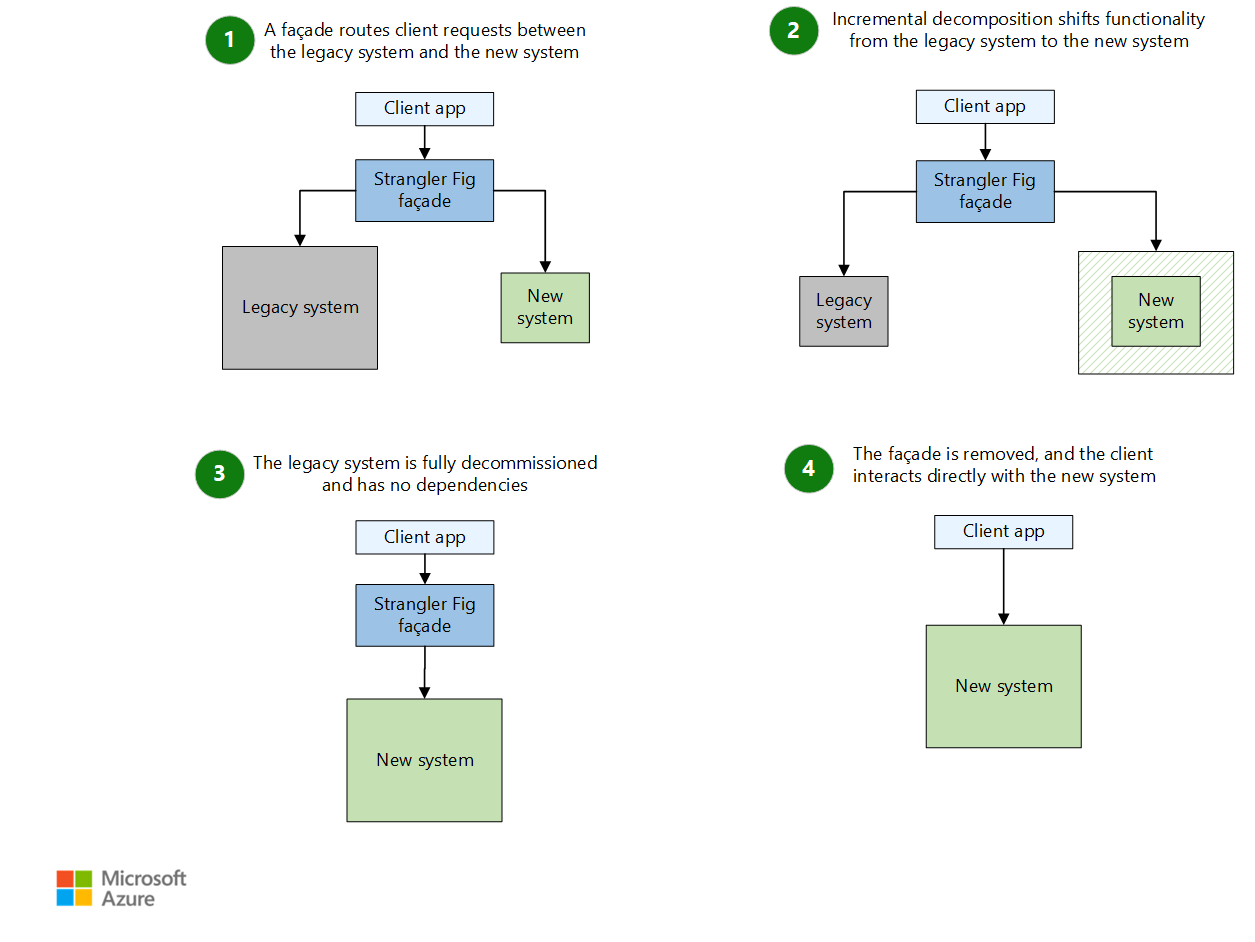Incrementally migrate a legacy system by gradually replacing specific pieces of functionality with new applications and services. As features from the legacy system are replaced, the new system eventually replaces all of the old system's features, strangling the old system and allowing you to decommission it.
Context and problem
As systems age, the development tools, hosting technology, and even system architectures they were built on can become increasingly obsolete. As new features and functionality are added, the complexity of these applications can increase dramatically, making them harder to maintain or add new features to.
Completely replacing a complex system can be a huge undertaking. Often, you will need a gradual migration to a new system, while keeping the old system to handle features that haven't been migrated yet. However, running two separate versions of an application means that clients have to know where particular features are located. Every time a feature or service is migrated, clients need to be updated to point to the new location.
Solution
Incrementally replace specific pieces of functionality with new applications and services. Create a façade that intercepts requests going to the backend legacy system. The façade routes these requests either to the legacy application or the new services. Existing features can be migrated to the new system gradually, and consumers can continue using the same interface, unaware that any migration has taken place.

This pattern helps to minimize risk from the migration, and spread the development effort over time. With the façade safely routing users to the correct application, you can add functionality to the new system at whatever pace you like, while ensuring the legacy application continues to function. Over time, as features are migrated to the new system, the legacy system is eventually "strangled" and is no longer necessary. Once this process is complete, the legacy system can safely be retired.
Issues and considerations
- Consider how to handle services and data stores that are potentially used by both new and legacy systems. Make sure both can access these resources side-by-side.
- Structure new applications and services in a way that they can easily be intercepted and replaced in future strangler fig migrations.
- At some point, when the migration is complete, the strangler fig façade will either go away or evolve into an adaptor for legacy clients.
- Make sure the façade keeps up with the migration.
- Make sure the façade doesn't become a single point of failure or a performance bottleneck.
When to use this pattern
Use this pattern when gradually migrating a back-end application to a new architecture.
This pattern may not be suitable:
- When requests to the back-end system cannot be intercepted.
- For smaller systems where the complexity of wholesale replacement is low.
Workload design
An architect should evaluate how the Strangler Fig pattern can be used in their workload's design to address the goals and principles covered in the Azure Well-Architected Framework pillars. For example:
| Pillar | How this pattern supports pillar goals |
|---|---|
| Reliability design decisions help your workload become resilient to malfunction and to ensure that it recovers to a fully functioning state after a failure occurs. | This pattern's incremental approach can help mitigate risks during a component transition vs large systemic changes. - RE:08 Testing |
| Cost Optimization is focused on sustaining and improving your workload's return on investment. | The goal of this approach is to maximize the use of existing investments in the currently running system while modernizing incrementally, as such it enables you to perform high-ROI replacements before low-ROI replacements. - CO:07 Component costs - CO:08 Environment costs |
| Operational Excellence helps deliver workload quality through standardized processes and team cohesion. | This pattern provides a continuous improvement approach, in which incremental replacement with small changes over time is preferred rather than large systemic changes that are riskier to implement. - OE:06 Workload development - OE:11 Safe deployment practices |
As with any design decision, consider any tradeoffs against the goals of the other pillars that might be introduced with this pattern.
Next steps
- Martin Fowler's blog post on StranglerFigApplication